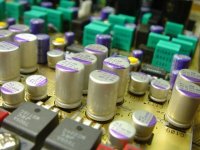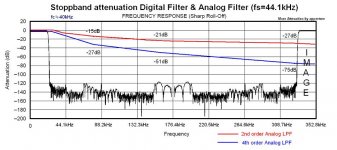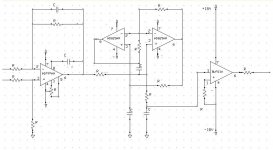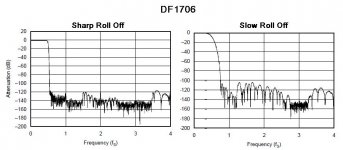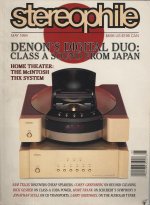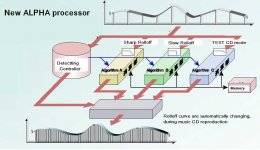The PCM63 datasheet has the following comment:
"The size of the offset decoupling capacitor is not critical either, with larger values (up to 100mF) giving slightly better SNR readings."
I guess this is why the PCM1704 recommends this value on the BPO DC pin...
I wouldn't dismiss the importance of ANY of the decouple pins.
"The size of the offset decoupling capacitor is not critical either, with larger values (up to 100mF) giving slightly better SNR readings."
I guess this is why the PCM1704 recommends this value on the BPO DC pin...
I wouldn't dismiss the importance of ANY of the decouple pins.
My PCM1704 DAC board
Hello PCM1704 enthusiasts,
I choice SANYO OS-CON for CAPs of PCM1704.
http://www.edc.sanyo.com/english/products/capacitor/oscon/download.html
As you know this SANYO OS-CON is very low ESR and good frequency characteristics.
1997, I used REF-DC was 47uF, SERVO DC was 47uF, BPO-DC was 100uF as is PCM1704 datasheet.
But from 2004, I am using REF-DC is 330uF, SERVO DC is 330uF, BPO-DC is 470uF not as is PCM1704 datasheet.
http://www.teddigital.com/COPS1708z201_en.html
Hello PCM1704 enthusiasts,
I choice SANYO OS-CON for CAPs of PCM1704.
http://www.edc.sanyo.com/english/products/capacitor/oscon/download.html
As you know this SANYO OS-CON is very low ESR and good frequency characteristics.
1997, I used REF-DC was 47uF, SERVO DC was 47uF, BPO-DC was 100uF as is PCM1704 datasheet.
But from 2004, I am using REF-DC is 330uF, SERVO DC is 330uF, BPO-DC is 470uF not as is PCM1704 datasheet.
http://www.teddigital.com/COPS1708z201_en.html
Attachments
PCM1704 DAC project
I created a PCM1704 based DAC for my own use. Not sure if anyone is interested in building this project, but I have additional circuit boards available. See the web site below for a little background and some photos. Also, the attached ZIP file has schematics, test results and photos.
http://home.comcast.net/~saudiodac24/site/
I created a PCM1704 based DAC for my own use. Not sure if anyone is interested in building this project, but I have additional circuit boards available. See the web site below for a little background and some photos. Also, the attached ZIP file has schematics, test results and photos.
http://home.comcast.net/~saudiodac24/site/
Re: PCM1704 DAC project
Make those filters deselectable (exp the terrible 4th order analog) and i could try it 🙂
What about the clock?
BTW, DIR9001 is a quite good receiver. I wonder why the wolfson 8804 is not in the likes of fellow diyers 😉
Feel free to email me more details.
rudee said:I created a PCM1704 based DAC for my own use. Not sure if anyone is interested in building this project, but I have additional circuit boards available. See the web site below for a little background and some photos. Also, the attached ZIP file has schematics, test results and photos.
http://home.comcast.net/~saudiodac24/site/
Make those filters deselectable (exp the terrible 4th order analog) and i could try it 🙂
What about the clock?
BTW, DIR9001 is a quite good receiver. I wonder why the wolfson 8804 is not in the likes of fellow diyers 😉
Feel free to email me more details.
Re: Re: PCM1704 DAC project
Can you explain this ? What is wrong with 4th order analog filters ?
Also, I tried to implement a low jitter clock scheme but was unsuccesful. This apparently was due to the dead band problem with the 4046 phase comparator. The jitter specs on the DIR9001 are quite good however.
Sorry, I do not have priveledge to send e-mail yet. Apparently my attachment did not post either.
Telstar said:
Make those filters deselectable (exp the terrible 4th order analog) and i could try it 🙂
Can you explain this ? What is wrong with 4th order analog filters ?
Also, I tried to implement a low jitter clock scheme but was unsuccesful. This apparently was due to the dead band problem with the 4046 phase comparator. The jitter specs on the DIR9001 are quite good however.
Sorry, I do not have priveledge to send e-mail yet. Apparently my attachment did not post either.
Re: Re: Re: PCM1704 DAC project
To post an attachment, hit the browse button at the bottom of the window. It has to be less than about 100K. Don't preview it.
rudee said:Apparently my attachment did not post either.
To post an attachment, hit the browse button at the bottom of the window. It has to be less than about 100K. Don't preview it.
Telstar,
I just figured out how to attach a file to my web site. Here is the URL again. There is a link at the bottom to the schematics, etc.
http://home.comcast.net/~saudiodac24
I just figured out how to attach a file to my web site. Here is the URL again. There is a link at the bottom to the schematics, etc.
http://home.comcast.net/~saudiodac24
Re: Re: Re: PCM1704 DAC project
I heard a (much better, on paper) 2nd order bessel analog filter and it... well killed the signal from a pcm1704 DAC. So I definitely dont want a 4th order one, it'll be like a winter blanket on the music.
rudee said:
Can you explain this ? What is wrong with 4th order analog filters ?
I heard a (much better, on paper) 2nd order bessel analog filter and it... well killed the signal from a pcm1704 DAC. So I definitely dont want a 4th order one, it'll be like a winter blanket on the music.
352.8kHz Image Noise and Analog LPF
Hello Telstar,
I think low order analog LPF is good for hearing music than high order.
But in 8fs interpolation D/A conversion, with digital filter like DF1706 and 2nd order analog LPF fc=40kHz, we must attenuate 8fs(352.8kHz) image noise.
Did you chack high frequency waveform quality that 20kHz signwae @fs=44.1kHz?
Hello Telstar,
I think low order analog LPF is good for hearing music than high order.
But in 8fs interpolation D/A conversion, with digital filter like DF1706 and 2nd order analog LPF fc=40kHz, we must attenuate 8fs(352.8kHz) image noise.
Did you chack high frequency waveform quality that 20kHz signwae @fs=44.1kHz?
Attachments
I must check spelling
Did you check high frequency waveform quality that 20kHz signwave @fs=44.1kHz?
Did you check high frequency waveform quality that 20kHz signwave @fs=44.1kHz?
Re: 352.8kHz Image Noise and Analog LPF
Yes, you are right. But I still didnt like the sound 😉
nagaesan said:Hello Telstar,
I think low order analog LPF is good for hearing music than high order.
But in 8fs interpolation D/A conversion, with digital filter like DF1706 and 2nd order analog LPF fc=40kHz, we must attenuate 8fs(352.8kHz) image noise.
Did you chack high frequency waveform quality that 20kHz signwae @fs=44.1kHz?
Yes, you are right. But I still didnt like the sound 😉
Analog LPF when we use 8fs DF DF1706 and 96kHz DIR DIR9001.
Hello Telstar,
Lets's talking about analog LPF when we use 8fs DF DF1706 and 96kHz DIR DIR9001.
You choiced 2nd order bessel analog filter. And rudee choiced 4th order. Now, many CD player manufactures choice 3rd order analog LPF with 8fs DF.
I imagine why rudee choice 4th order LPF, that he used DIR9001, this is OK fs=96kHz. If this passband are 40kHz when 96kHz source, cutoff frequency is over 60kHz or 80kHz.
I think that there are various opinions, how far should suppress the 352.8kHz image noise, but when we should think about LPF, it is necessary to think in a partial part.
1)Source 44.1kHz or 96kHz
2) Cut off frequency 40kHz or 60kHz or 80kHz or 100kHz
3) Decrement -12dB/oct or -18dB/oct or -24dB/oct
4) Characteristic Bessel or Chebyshev Type1 or Type2 or Butterworth or Elliptic
5)Type of circuit Sallen-key or GIC or passive
By the way, this is 3rd order GIC analog LPF of my PCM1704 board.How do you think about this at 8fs over sampling @fs=44.1kHz?
Hello Telstar,
Lets's talking about analog LPF when we use 8fs DF DF1706 and 96kHz DIR DIR9001.
You choiced 2nd order bessel analog filter. And rudee choiced 4th order. Now, many CD player manufactures choice 3rd order analog LPF with 8fs DF.
I imagine why rudee choice 4th order LPF, that he used DIR9001, this is OK fs=96kHz. If this passband are 40kHz when 96kHz source, cutoff frequency is over 60kHz or 80kHz.
I think that there are various opinions, how far should suppress the 352.8kHz image noise, but when we should think about LPF, it is necessary to think in a partial part.
1)Source 44.1kHz or 96kHz
2) Cut off frequency 40kHz or 60kHz or 80kHz or 100kHz
3) Decrement -12dB/oct or -18dB/oct or -24dB/oct
4) Characteristic Bessel or Chebyshev Type1 or Type2 or Butterworth or Elliptic
5)Type of circuit Sallen-key or GIC or passive
By the way, this is 3rd order GIC analog LPF of my PCM1704 board.How do you think about this at 8fs over sampling @fs=44.1kHz?
Attachments
nagaesan, how do you like "slow" roll-off in digital filter (df1706) ?
I want to try 4x OS (192khz exactly) "slow" and 3rd order 18dB/oct low pass, maybe not enough? I only care about HF supression this time , no slew rate related. Just simulated, im down to -120 dB at 38000 hz with this digital filter.
BTW Im sure your design qualifies as enough HF supression , but not so sure about mine
I want to try 4x OS (192khz exactly) "slow" and 3rd order 18dB/oct low pass, maybe not enough? I only care about HF supression this time , no slew rate related. Just simulated, im down to -120 dB at 38000 hz with this digital filter.
BTW Im sure your design qualifies as enough HF supression , but not so sure about mine

The Slow Roll off effect between DF1706 and Wadia's
My opinion of Slow Roll curve of Over Sampling FIR Digital Filter @fs=44.1kHz source hearing is follows.(Please do not be angry I write this reason clearly.)
-- Tetsuya's opinion --
1) It was nice idea, that one stage interpolation, very low Taps FIR filter like Wadia 2000, 2000SH, 64.4, etc...
2) It is stupid things, that 3 stage cascading type interpolation DF.
The interpolation FIR filter of Wadia 2000 was used AT&T DSP16 x 4. And this FIR filter is one stage interpolation with very fast oversampling that was 16fs but very low TAP (15 TAP FIR), because using DSP which there was a limit potential.
Naturally, this very low TAP FIR filter's roll off curve was came to "Slow Roll Off".
When I tested Wadia 64.4 D/A converter @20kHz signwave, there was amplitude modulation and response was -2.7dB.
But the sound of Wadia 64.4 was very nice because this model has "One stage" FIR filter and good analog circuit.
I think that you remember in about 1989 to 1992, it was prevalent "Slow Roll Off". Luxman DA07 and Pioneer PD-T09 with "Legart Link Conversion" are "One stage FIR filter with Slow Roll Off"
And in 1992, NPC rereased SM5843A slow roll off FIR filter for ONKYO integra C-1E.
As you know SM5843A is 3 stage cascading type interpolation Digital Filter, output word length was 20bit, and internal 21 x 22bit parallel multiplier / 25bit accumlator.
About 1992 or 93, I was contacting NPC (Nihon Precision Circuits) people for planning DENON DA-S1/DP-S1 and DCD-S1 CD Player. NPC people Mr.Tohyama and Mr.Takeda requested me to adopt SM5843A for DCD-S1.
But I said "No thank you, I don't like slow roll off DF".
When I say like that, NPC people explained me, "SM5843A has Slow Roll Off also Sharp Roll Off curve".
In sharp roll off mode, the 1st stage of interpolator was 2fs oversampling with 153TAP FIR, 2nd stage was 29TAP, and final stage was 17TAP. It was nice stop band attenuation spec.
And in slow roll off mode, the the 1st stage of interpolator was 2fs oversampling with 25TAP FIR, 2nd stage was 29TAP, and final stage was 17TAP.
Then we adopted highly cost SM5842AP for DA-S1, but we need much more low cost DF for DCD-S1.
For such a reason, we DENON adopted SM5843A with sharp roll off mode for DCD-S1.
Mr.tritosine, if you know, please tell me, what's purpose and effect of Slow Roll Off curve in 3 stage FIR filter like DF1706?
My opinion of Slow Roll curve of Over Sampling FIR Digital Filter @fs=44.1kHz source hearing is follows.(Please do not be angry I write this reason clearly.)
-- Tetsuya's opinion --
1) It was nice idea, that one stage interpolation, very low Taps FIR filter like Wadia 2000, 2000SH, 64.4, etc...
2) It is stupid things, that 3 stage cascading type interpolation DF.
The interpolation FIR filter of Wadia 2000 was used AT&T DSP16 x 4. And this FIR filter is one stage interpolation with very fast oversampling that was 16fs but very low TAP (15 TAP FIR), because using DSP which there was a limit potential.
Naturally, this very low TAP FIR filter's roll off curve was came to "Slow Roll Off".
When I tested Wadia 64.4 D/A converter @20kHz signwave, there was amplitude modulation and response was -2.7dB.
But the sound of Wadia 64.4 was very nice because this model has "One stage" FIR filter and good analog circuit.
I think that you remember in about 1989 to 1992, it was prevalent "Slow Roll Off". Luxman DA07 and Pioneer PD-T09 with "Legart Link Conversion" are "One stage FIR filter with Slow Roll Off"
And in 1992, NPC rereased SM5843A slow roll off FIR filter for ONKYO integra C-1E.
As you know SM5843A is 3 stage cascading type interpolation Digital Filter, output word length was 20bit, and internal 21 x 22bit parallel multiplier / 25bit accumlator.
About 1992 or 93, I was contacting NPC (Nihon Precision Circuits) people for planning DENON DA-S1/DP-S1 and DCD-S1 CD Player. NPC people Mr.Tohyama and Mr.Takeda requested me to adopt SM5843A for DCD-S1.
But I said "No thank you, I don't like slow roll off DF".
When I say like that, NPC people explained me, "SM5843A has Slow Roll Off also Sharp Roll Off curve".
In sharp roll off mode, the 1st stage of interpolator was 2fs oversampling with 153TAP FIR, 2nd stage was 29TAP, and final stage was 17TAP. It was nice stop band attenuation spec.
And in slow roll off mode, the the 1st stage of interpolator was 2fs oversampling with 25TAP FIR, 2nd stage was 29TAP, and final stage was 17TAP.
Then we adopted highly cost SM5842AP for DA-S1, but we need much more low cost DF for DCD-S1.
For such a reason, we DENON adopted SM5843A with sharp roll off mode for DCD-S1.
Mr.tritosine, if you know, please tell me, what's purpose and effect of Slow Roll Off curve in 3 stage FIR filter like DF1706?
Attachments
well Im too beginning to think this "cascaded FIR+combfilter + slow roll off" combination isnt too interesting idea heh, In fact I too want to use precomputed 192khz .wav file results of 64bit algorithm thats not even running in real time ...
Re: The Slow Roll off effect between DF1706 and Wadia's
Hi Mr. Tetsuya, excuse my basic questions because I am a totally newbie ( but I have good ear ! 🙂
I do not understand 100% your comments 1) and 2).
Is it nice idea or "stupid" idea ? ( or ironic ? )
Excuse again, Please what is TAP ?
Agreeed about the nice sound of wadia, but IMHO his analog output stage is "rubbish" ! 🙂
I think ( theory) the impulse response and indicial response is the key; am I wrong?
WOW!! Are you the designer of the famous Denon Alpha Processor?
I am lucky today! 🙂
This is near incredible, The DCD S-1 in Italy was very expansive ( about 5000 euros ) !!!!!!
A friend of mine has purchased the 2-chassis DA-S1 + transport ( 15 years ago? ) . I was amazed how good ( analog like) they sounded!
Incredible. IMHO a lot better of wadias ( IMHO measurements of alpha processor confirm this ) . I have justified also ( in my mind) since the presence of a fully discrete class/a ZNFB components output stage of the DA-S1, a rarity for a japanese DAC ! :-(
Am I the only who think so?
Cheers,
Paolo - Venezia -Italy
nagaesan said:
-- Tetsuya's opinion --
1) It was nice idea, that one stage interpolation, very low Taps FIR filter like Wadia 2000, 2000SH, 64.4, etc...
2) It is stupid things, that 3 stage cascading type interpolation DF.
Hi Mr. Tetsuya, excuse my basic questions because I am a totally newbie ( but I have good ear ! 🙂
I do not understand 100% your comments 1) and 2).
Is it nice idea or "stupid" idea ? ( or ironic ? )
The interpolation FIR filter of Wadia 2000 was used AT&T DSP16 x 4. And this FIR filter is one stage interpolation with very fast oversampling that was 16fs but very low TAP (15 TAP FIR), because using DSP which there was a limit potential.
Naturally, this very low TAP FIR filter's roll off curve was came to "Slow Roll Off".
When I tested Wadia 64.4 D/A converter @20kHz signwave, there was amplitude modulation and response was -2.7dB. [/B]
Excuse again, Please what is TAP ?
But the sound of Wadia 64.4 was very nice because this model has "One stage" FIR filter and good analog circuit.
[/B]
Agreeed about the nice sound of wadia, but IMHO his analog output stage is "rubbish" ! 🙂
I think ( theory) the impulse response and indicial response is the key; am I wrong?
I think that you remember in about 1989 to 1992, it was prevalent "Slow Roll Off". Luxman DA07 and Pioneer PD-T09 with "Legart Link Conversion" are "One stage FIR filter with Slow Roll Off"
And in 1992, NPC rereased SM5843A slow roll off FIR filter for ONKYO integra C-1E.
As you know SM5843A is 3 stage cascading type interpolation Digital Filter, output word length was 20bit, and internal 21 x 22bit parallel multiplier / 25bit accumlator.
About 1992 or 93, I was contacting NPC (Nihon Precision Circuits) people for planning DENON DA-S1/DP-S1 and DCD-S1 CD Player. NPC people Mr.Tohyama and Mr.Takeda requested me to adopt SM5843A for DCD-S1.
But I said "No thank you, I don't like slow roll off DF".
When I say like that, NPC people explained me, "SM5843A has Slow Roll Off also Sharp Roll Off curve".
In sharp roll off mode, the 1st stage of interpolator was 2fs oversampling with 153TAP FIR, 2nd stage was 29TAP, and final stage was 17TAP. It was nice stop band attenuation spec.
And in slow roll off mode, the the 1st stage of interpolator was 2fs oversampling with 25TAP FIR, 2nd stage was 29TAP, and final stage was 17TAP. [/B]
WOW!! Are you the designer of the famous Denon Alpha Processor?
I am lucky today! 🙂
Then we adopted highly cost SM5842AP for DA-S1, but we need much more low cost DF for DCD-S1.
For such a reason, we DENON adopted SM5843A with sharp roll off mode for DCD-S1.
[/B]
This is near incredible, The DCD S-1 in Italy was very expansive ( about 5000 euros ) !!!!!!
A friend of mine has purchased the 2-chassis DA-S1 + transport ( 15 years ago? ) . I was amazed how good ( analog like) they sounded!
Incredible. IMHO a lot better of wadias ( IMHO measurements of alpha processor confirm this ) . I have justified also ( in my mind) since the presence of a fully discrete class/a ZNFB components output stage of the DA-S1, a rarity for a japanese DAC ! :-(
Am I the only who think so?
Cheers,
Paolo - Venezia -Italy
OLD BOY
Hello inertial,
I am OLD boy DENON planning div.
1993, I planned this separate CDP with ALPHA processing.
http://www.teddigital.com/ALPHA1.htm <----Sorry Japanese
If your friend still has DCD-S1, please teach him, he can easily take D/A board off, and replace new board.
http://www.teddigital.com/COPS1708z201_en.html
Hello inertial,
I am OLD boy DENON planning div.
1993, I planned this separate CDP with ALPHA processing.
http://www.teddigital.com/ALPHA1.htm <----Sorry Japanese
If your friend still has DCD-S1, please teach him, he can easily take D/A board off, and replace new board.
http://www.teddigital.com/COPS1708z201_en.html
Attachments
No, he was so stupid to sold it! 
Tetsuya San, if you have planned that ALPHA IMO you was a genius!😎
Why people do not have understood how goods was those Denons?😕
Another friend of mine has now a wadia 25 DAC + Teac P2s. It is good IMO, but big Denons pair DP-1 & DA-S1 was clearly better to my ear ( direct comparision with good LP of course).
My sincerly admiration🙂
Cheers,
Paolo

Tetsuya San, if you have planned that ALPHA IMO you was a genius!😎
Why people do not have understood how goods was those Denons?😕
Another friend of mine has now a wadia 25 DAC + Teac P2s. It is good IMO, but big Denons pair DP-1 & DA-S1 was clearly better to my ear ( direct comparision with good LP of course).
My sincerly admiration🙂
Cheers,
Paolo
SharpRolloff and SlowRolloff automatic changing
Hi! inertial, thank you.
I am not a developper but a planner of ALPHA processing of DA-S1 or DCD-S1. This developper of ALPHA was Dr.Hayashi and Mr.Ohtsuka. And now I moved to the other sections, recently, young DENON people are in charge this renewal and development.
For such a reason I have no plan of inprovement of ALPHA processing, but recently there is the part which I cannot understand new ALPHA processing which young people developed.
Original ALPHA processing in 1993 has 2 function.
One is Adaptive Line Pattern Harmonized Algorithm that revises 1LSB stepped wave pattern.
Two is Automatic Low Pass filter Harmonic Adjustment that playback no ringing impulse waveform, more beautiful than WADIA's when we played a test CD.
New ALPHA processing from 2004 has 3 function.
One and Two are same as 1993 original.
Three is "Slow Rolloff" and "Sharp Rolloff" automatic changing function. And these new generation model has very long TAP FIR filter made by powerfull Analog Devices's SHARC DSP.
I think it is no problem, when changing rolloff curve with muring .
I think DA-S1 was not perfect, there are many points that we should be improved refer to WADIA's nice circuit, but I do not admire that doing a thing. Still I don't like "Slow Rolloff".
If there is a person knowing FIR filter, please teach it to young generation people that changing characteristic of rolloff curve, during music reproduction is nice function?.
Hi! inertial, thank you.
I am not a developper but a planner of ALPHA processing of DA-S1 or DCD-S1. This developper of ALPHA was Dr.Hayashi and Mr.Ohtsuka. And now I moved to the other sections, recently, young DENON people are in charge this renewal and development.
For such a reason I have no plan of inprovement of ALPHA processing, but recently there is the part which I cannot understand new ALPHA processing which young people developed.
Original ALPHA processing in 1993 has 2 function.
One is Adaptive Line Pattern Harmonized Algorithm that revises 1LSB stepped wave pattern.
Two is Automatic Low Pass filter Harmonic Adjustment that playback no ringing impulse waveform, more beautiful than WADIA's when we played a test CD.
New ALPHA processing from 2004 has 3 function.
One and Two are same as 1993 original.
Three is "Slow Rolloff" and "Sharp Rolloff" automatic changing function. And these new generation model has very long TAP FIR filter made by powerfull Analog Devices's SHARC DSP.
I think it is no problem, when changing rolloff curve with muring .
I think DA-S1 was not perfect, there are many points that we should be improved refer to WADIA's nice circuit, but I do not admire that doing a thing. Still I don't like "Slow Rolloff".
If there is a person knowing FIR filter, please teach it to young generation people that changing characteristic of rolloff curve, during music reproduction is nice function?.
Attachments
- Home
- Source & Line
- Digital Line Level
- PCM1704 or newer chips?
